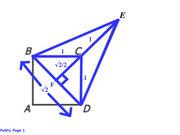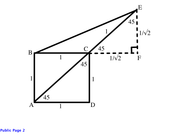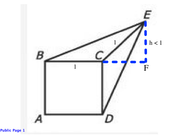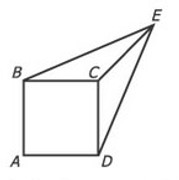In the figure attached with this post, each side of square ABCD has length 1, the length of line
Segment CE is 1, and the length of line segment BE is equal to the length
Of line segment DE. What is the area of the triangular region BCE?
a. 1/3 b. (2^-2 )/4 c. 1/2
d. (2^-2)/2 e. 3/4
OA: D
Please explain how to solve this??
Figure
This topic has expert replies
- relic
- Junior | Next Rank: 30 Posts
- Posts: 22
- Joined: Tue Mar 31, 2009 5:28 am
- Thanked: 3 times
- GMAT Score:780
I'm assuming you mislabeled the answers with -2 exponents when you meant (1/2) exponents representing a square root.
The area of a triangle is half the product of the base and height. For BCE let's make CE the base. Now we need the perpendicular height from CE to point B.
Since BE=DE, BDE is an isoceles triangle, so if we extend CE through the square we'll hit point A. The intersection of a square's diagonals is always perpendicular, so the intersection creates our needed perpendicular distance between CE and point B.
The diagonal of ABCD is sqrt(2) so we take half of this and we have BCE's height. So, BCE has a base of 1 and a height of sqrt(2)/2. Let's use the forumla:
(1/2)(1)(sqrt(2)/2) = sqrt(2)/4
This is not the answer you indicated, though I believe it is correct.
The area of a triangle is half the product of the base and height. For BCE let's make CE the base. Now we need the perpendicular height from CE to point B.
Since BE=DE, BDE is an isoceles triangle, so if we extend CE through the square we'll hit point A. The intersection of a square's diagonals is always perpendicular, so the intersection creates our needed perpendicular distance between CE and point B.
The diagonal of ABCD is sqrt(2) so we take half of this and we have BCE's height. So, BCE has a base of 1 and a height of sqrt(2)/2. Let's use the forumla:
(1/2)(1)(sqrt(2)/2) = sqrt(2)/4
This is not the answer you indicated, though I believe it is correct.
-
cm47323
- Junior | Next Rank: 30 Posts
- Posts: 26
- Joined: Tue Oct 21, 2008 12:10 pm
- Thanked: 3 times
- GMAT Score:770
No, it isn't. What's the source?ketkoag wrote:Now the correct answer is 1/8 i.e. answer choice D.
Also how u've considered CE and CA on a single straight line EA.
Please elaborate the solution.
While GMAT diagrams are not necessarily to scale, this is an abomination. There is no line segment DE. Fwiw, I solved it as worded with angle BCE = 135 and got sqrt(2)/4. Please don't make up questions and post them on here unless capable of solving it yourself. If you used a source, check it more carefully.
- Vemuri
- Legendary Member
- Posts: 682
- Joined: Fri Jan 16, 2009 2:40 am
- Thanked: 32 times
- Followed by:1 members
reasonable explanation to me. Is anyone contesting this solution?relic wrote:I'm assuming you mislabeled the answers with -2 exponents when you meant (1/2) exponents representing a square root.
The area of a triangle is half the product of the base and height. For BCE let's make CE the base. Now we need the perpendicular height from CE to point B.
Since BE=DE, BDE is an isoceles triangle, so if we extend CE through the square we'll hit point A. The intersection of a square's diagonals is always perpendicular, so the intersection creates our needed perpendicular distance between CE and point B.
The diagonal of ABCD is sqrt(2) so we take half of this and we have BCE's height. So, BCE has a base of 1 and a height of sqrt(2)/2. Let's use the forumla:
(1/2)(1)(sqrt(2)/2) = sqrt(2)/4
This is not the answer you indicated, though I believe it is correct.
cm47323, ive not made up the question and is directly from the GMAT sets.
Now, about the answer, i got the same answer as relic did. but OA was something different, so i posted here to clear the doubt. please lemme know if u have any querries regarding this..
Now, about the answer, i got the same answer as relic did. but OA was something different, so i posted here to clear the doubt. please lemme know if u have any querries regarding this..
-
chandni170
- Newbie | Next Rank: 10 Posts
- Posts: 4
- Joined: Fri Jul 05, 2013 1:07 am
Just got this in my test.
OA is B.
Since I didn't have enough time to literally solve it, I made an educated guess, used POE and moved on. Fortunately it worked.
Here's how I approached it:
Given:
- ABCD are all equal to 1; therefore BC=1
- CE=1
- BE=DE
Area of BCE = 1/2 x BC (base) x height (ht: perpendicular dropped from E, bisecting BC)
Since ht is the perpendicular distance and CE is the hypotenuse, height<1
Therefore area of BCE = 1/2 x 1 x something less than 1 = LT 1/2------- (this narrows down ur options to A and B)
Now A and B are very close: A= 0.33 and B=0.32.
I chose B
It would be great if any expert can help me figure out whether there's any solid way to eliminate A (other than the approach already mentioned in the post)
My exam is around the corner and any quick help would be highly appreciated.
Thanks in advance!
OA is B.
Since I didn't have enough time to literally solve it, I made an educated guess, used POE and moved on. Fortunately it worked.
Here's how I approached it:
Given:
- ABCD are all equal to 1; therefore BC=1
- CE=1
- BE=DE
Area of BCE = 1/2 x BC (base) x height (ht: perpendicular dropped from E, bisecting BC)
Since ht is the perpendicular distance and CE is the hypotenuse, height<1
Therefore area of BCE = 1/2 x 1 x something less than 1 = LT 1/2------- (this narrows down ur options to A and B)
Now A and B are very close: A= 0.33 and B=0.32.
I chose B
It would be great if any expert can help me figure out whether there's any solid way to eliminate A (other than the approach already mentioned in the post)
My exam is around the corner and any quick help would be highly appreciated.
Thanks in advance!
- GMATGuruNY
- GMAT Instructor
- Posts: 15539
- Joined: Tue May 25, 2010 12:04 pm
- Location: New York, NY
- Thanked: 13060 times
- Followed by:1906 members
- GMAT Score:790
Approach 1:

In square ABCD, since s=1, BD = √2 and CF = √2/2.
It is given that CE=1.
Thus, EF = √2/2 + 1.
∆BED = (1/2)(BD)(EF) = (1/2)(√2)(√2/2 + 1) = (1/2)(1 + √2) = 1/2 + √2/2.
∆BCD = (1/2)(square ABCD) = 1/2.
Quadrilateral BEDC = ∆BED - ∆BCD = (1/2 + √2/2) - 1/2 = √2/2.
∆BCE = (1/2)(quadrilateral BEDC) = (1/2)(√2/2) = √2/4.
The correct answer is B.
Approach 2:

∆ECF:
Since AB || CF, ∠ECF = 45 degrees.
Thus, is a ∆ECF is a 45-45-90 triangle.
In a 45-45-90 triangle, the sides are in the following ratio:
x : x : x√2.
Since it is given the CE=1, EF = 1/√2 = (1*√2)/(√2*√2) = √2/2.
∆BCE:
If we consider BC the base, then EF is the corresponding height.
Thus, the area of ∆BCE = (1/2)(b)(h) = (1/2)(1)(√2/2) = √2/4.
The correct answer is B.
Private tutor exclusively for the GMAT and GRE, with over 20 years of experience.
Followed here and elsewhere by over 1900 test-takers.
I have worked with students based in the US, Australia, Taiwan, China, Tajikistan, Kuwait, Saudi Arabia -- a long list of countries.
My students have been admitted to HBS, CBS, Tuck, Yale, Stern, Fuqua -- a long list of top programs.
As a tutor, I don't simply teach you how I would approach problems.
I unlock the best way for YOU to solve problems.
For more information, please email me (Mitch Hunt) at [email protected].
Student Review #1
Student Review #2
Student Review #3
Followed here and elsewhere by over 1900 test-takers.
I have worked with students based in the US, Australia, Taiwan, China, Tajikistan, Kuwait, Saudi Arabia -- a long list of countries.
My students have been admitted to HBS, CBS, Tuck, Yale, Stern, Fuqua -- a long list of top programs.
As a tutor, I don't simply teach you how I would approach problems.
I unlock the best way for YOU to solve problems.
For more information, please email me (Mitch Hunt) at [email protected].
Student Review #1
Student Review #2
Student Review #3
-
Matt@VeritasPrep
- GMAT Instructor
- Posts: 2630
- Joined: Wed Sep 12, 2012 3:32 pm
- Location: East Bay all the way
- Thanked: 625 times
- Followed by:119 members
- GMAT Score:780
Chandni, I think your approach is very resourceful - this is exactly the sort of improvisational problem solving the GMAT tests for.chandni170 wrote: I chose B
It would be great if any expert can help me figure out whether there's any solid way to eliminate A (other than the approach already mentioned in the post)
My exam is around the corner and any quick help would be highly appreciated.
Thanks in advance!
I'd be skeptical of A just because there's no √ in it. The base of the triangle is clearly 1, but the height is so unlikely to be an integer -- even if we can't prove it, we should sense that this is one of our familiar ∆s, such as a 30-60-90 or a 45-45-90 -- that a √ should appear somewhere in the height, and hence in the area.
How can asswer it under 2 minutes its very difficult to think in this way under 2 minutesGMATGuruNY wrote:Approach 1:
In square ABCD, since s=1, BD = √2 and CF = √2/2.
It is given that CE=1.
Thus, EF = √2/2 + 1.
∆BED = (1/2)(BD)(EF) = (1/2)(√2)(√2/2 + 1) = (1/2)(1 + √2) = 1/2 + √2/2.
∆BCD = (1/2)(square ABCD) = 1/2.
Quadrilateral BEDC = ∆BED - ∆BCD = (1/2 + √2/2) - 1/2 = √2/2.
∆BCE = (1/2)(quadrilateral BEDC) = (1/2)(√2/2) = √2/4.
The correct answer is B.
Approach 2:
∆ECF:
Since AB || CF, ∠ECF = 45 degrees.
Thus, is a ∆ECF is a 45-45-90 triangle.
In a 45-45-90 triangle, the sides are in the following ratio:
x : x : x√2.
Since it is given the CE=1, EF = 1/√2 = (1*√2)/(√2*√2) = √2/2.
∆BCE:
If we consider BC the base, then EF is the corresponding height.
Thus, the area of ∆BCE = (1/2)(b)(h) = (1/2)(1)(√2/2) = √2/4.
The correct answer is B.
- GMATGuruNY
- GMAT Instructor
- Posts: 15539
- Joined: Tue May 25, 2010 12:04 pm
- Location: New York, NY
- Thanked: 13060 times
- Followed by:1906 members
- GMAT Score:790
An alternate approach is to BALLPARK.Asma77 wrote:How can asswer it under 2 minutes its very difficult to think in this way under 2 minutes

In the figure above, EF is the height of ∆BCE.
As the figure illustrates, since EC=1, height EF is less than 1.
Thus:
Area of ∆BCE = (1/2)bh = (1/2)(BC)(EF) = (1/2)(1)(less than 1) = less than 1/2.
Eliminate C, D and E, since none of these answer choices is less than 1/2.
The diagonal of a square with side s = s√2.
Since the problem above includes a square, answer choice B -- which includes √2 -- seems more likely to be correct than answer choice A.
Select B and move on to the next problem.
Private tutor exclusively for the GMAT and GRE, with over 20 years of experience.
Followed here and elsewhere by over 1900 test-takers.
I have worked with students based in the US, Australia, Taiwan, China, Tajikistan, Kuwait, Saudi Arabia -- a long list of countries.
My students have been admitted to HBS, CBS, Tuck, Yale, Stern, Fuqua -- a long list of top programs.
As a tutor, I don't simply teach you how I would approach problems.
I unlock the best way for YOU to solve problems.
For more information, please email me (Mitch Hunt) at [email protected].
Student Review #1
Student Review #2
Student Review #3
Followed here and elsewhere by over 1900 test-takers.
I have worked with students based in the US, Australia, Taiwan, China, Tajikistan, Kuwait, Saudi Arabia -- a long list of countries.
My students have been admitted to HBS, CBS, Tuck, Yale, Stern, Fuqua -- a long list of top programs.
As a tutor, I don't simply teach you how I would approach problems.
I unlock the best way for YOU to solve problems.
For more information, please email me (Mitch Hunt) at [email protected].
Student Review #1
Student Review #2
Student Review #3
- gui_guimaraes
- Senior | Next Rank: 100 Posts
- Posts: 38
- Joined: Thu Dec 17, 2015 9:22 am
@GMATGuruNYGMATGuruNY wrote: ↑Sun Oct 26, 2014 11:34 pmApproach 1:
In square ABCD, since s=1, BD = √2 and CF = √2/2.
It is given that CE=1.
Thus, EF = √2/2 + 1.
∆BED = (1/2)(BD)(EF) = (1/2)(√2)(√2/2 + 1) = (1/2)(1 + √2) = 1/2 + √2/2.
∆BCD = (1/2)(square ABCD) = 1/2.
Quadrilateral BEDC = ∆BED - ∆BCD = (1/2 + √2/2) - 1/2 = √2/2.
∆BCE = (1/2)(quadrilateral BEDC) = (1/2)(√2/2) = √2/4.
The correct answer is B.
Approach 2:
∆ECF:
Since AB || CF, ∠ECF = 45 degrees.
Thus, is a ∆ECF is a 45-45-90 triangle.
In a 45-45-90 triangle, the sides are in the following ratio:
x : x : x√2.
Since it is given the CE=1, EF = 1/√2 = (1*√2)/(√2*√2) = √2/2.
∆BCE:
If we consider BC the base, then EF is the corresponding height.
Thus, the area of ∆BCE = (1/2)(b)(h) = (1/2)(1)(√2/2) = √2/4.
The correct answer is B.
How do you know that AE would be a straight line? We know that AD||BC, but we don't know that AE is a continuation of AE. So, how do you know for sure? Many tks!




















